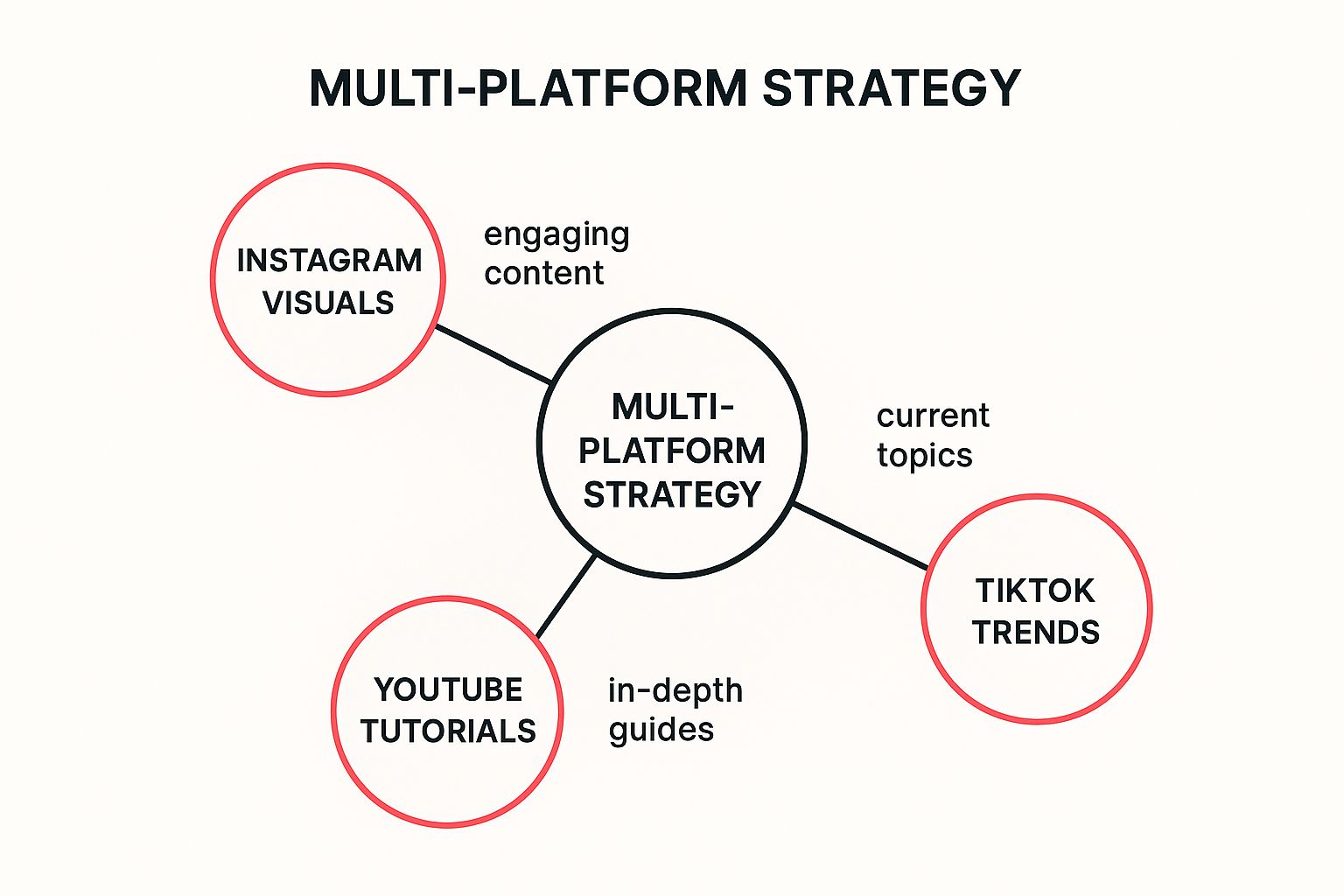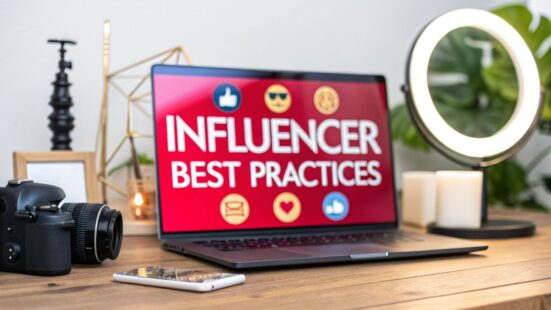 Influencer Strategy for Brands – Full Breakdown, Tips, FAQs & More
Influencer Strategy for Brands – Full Breakdown, Tips, FAQs & More
Table of Contents
Elevate Your Brand with Powerful Influencer Collaborations
Want to maximize your ROI through influencer marketing? This listicle outlines eight influencer marketing best practices to strengthen your campaigns and achieve measurable results. Learn how authentic partnerships, data-driven influencer selection, clear contracts, multi-platform strategies, performance-based compensation, and long-term relationship building can elevate your brand. We’ll also cover content co-creation and comprehensive performance measurement. These influencer marketing best practices will help you navigate the complexities of creator collaborations and achieve significant growth.
1. Authentic Partnership Creation
Authentic partnership creation is arguably the most crucial influencer marketing best practice. It forms the bedrock of any successful campaign and sets the stage for genuine connection with target audiences. This approach prioritizes building relationships with influencers whose values, content style, and audience demographics truly align with your brand identity. Instead of chasing large follower counts, focus on engagement rates, audience trust, and a natural synergy between the influencer’s personal brand and your products or services. This fosters a sense of genuine advocacy that resonates far more deeply with consumers than forced or generic promotions.

Authentic partnerships are characterized by several key features: a clear alignment of values and aesthetics between the brand and influencer; a focus on cultivating long-term relationships rather than executing one-off campaigns; a mutual belief in the product or service being promoted; and content creation that feels organic and seamlessly integrates into the influencer’s existing feed. This approach fosters a sense of genuine advocacy that resonates far more deeply with consumers than forced or generic promotions. Think of it less as advertising and more as collaborative storytelling.
Examples of Successful Implementation:
- Glossier: Built a loyal following by partnering with everyday customers-turned-micro-influencers who genuinely loved their products before any formal collaboration.
- REI: Collaborates with outdoor enthusiasts who authentically use and appreciate their equipment in real-life adventures, strengthening their brand image within the outdoor community.
- Gymshark: Developed a robust athlete program featuring fitness influencers who embody the brand’s ethos and actively use their products, fostering a strong sense of community and shared passion.
When and Why to Use This Approach:
This strategy is ideal for brands aiming to build long-term brand loyalty and foster genuine connections with their target audience. It is particularly effective for DTC and e-commerce brands, startups, and companies launching new products who want to establish credibility and trust. While it may require a more significant time investment upfront, the resulting increase in engagement, brand affinity, and authentic content makes it a worthwhile investment for sustainable growth.
Pros:
- Higher engagement rates from authentically interested audiences
- Increased trust and credibility with consumers
- Better content quality that resonates organically with followers
- Lower risk of partnership backlash or controversy
Cons:
- May limit the pool of available influencers for collaboration
- Can be more time-consuming to find the perfect match
- Potentially higher costs for genuine brand advocates
- May reach smaller audiences compared to mega-influencers
Actionable Tips:
- Thorough Research: Scrutinize an influencer’s past content and audience engagement to ensure alignment with your brand values.
- Personal Connection: Conduct introductory calls to assess personal chemistry and ensure a shared vision for the partnership.
- Start Small: Begin with smaller collaborations to test the waters before committing to long-term partnerships.
- Creative Freedom: Allow influencers creative freedom to maintain their authentic voice and ensure content resonates with their audience.
Popularized By:
Brands like Daniel Wellington (#DWPickoftheDay), Fashion Nova (body-positive influencers), and Outdoor Voices (#DoingThings) have successfully leveraged authentic influencer marketing to build strong communities and drive significant brand growth.
Authentic partnership creation deserves its place at the top of any influencer marketing best practices list because it establishes the foundation for genuine and impactful campaigns. By prioritizing authentic connections and shared values, brands can build lasting relationships with influencers and their audiences, fostering a powerful sense of community and brand loyalty.
2. Data-Driven Influencer Selection
One of the most crucial influencer marketing best practices is data-driven influencer selection. This method involves moving beyond gut feelings and surface-level observations to leverage concrete data and analytics for identifying the ideal influencers for your campaigns. Instead of simply choosing influencers based on popularity or perceived relevance, brands using this approach delve into audience demographics, engagement metrics, content performance history, and brand affinity data to pinpoint influencers whose audience aligns perfectly with their target market. This ensures that your marketing message reaches the right people, maximizing the impact of your campaigns.

Data-driven influencer selection incorporates several key features: analyzing audience demographics (age, location, gender, interests); calculating and benchmarking engagement rates; assessing audience quality (identifying real vs. fake followers); analyzing content performance across various platforms; and conducting brand affinity and competitive analysis. For example, you can analyze the demographics of an influencer’s followers to ensure they match your ideal customer profile. Analyzing past content performance can reveal which influencers consistently deliver engaging content that resonates with their audience. Brand affinity analysis can help you determine if the influencer’s values and audience align with your brand image.
This approach offers numerous advantages. It leads to a higher ROI on influencer investments by ensuring that your budget is allocated effectively. It mitigates the risk of partnering with influencers who don’t resonate with your target audience, leading to more precise targeting of desired customer segments. Furthermore, data-driven selection empowers you to make informed decisions based on concrete evidence, rather than relying on assumptions or guesswork. This translates to better campaign performance prediction and more efficient resource allocation.
However, it’s important to acknowledge the potential drawbacks. Data-driven influencer selection often requires investment in specialized analytics tools or partnerships with agencies that offer such services. Data privacy concerns and regulations can sometimes limit access to certain metrics. Furthermore, relying solely on data can overlook intangible factors like an influencer’s creativity, authenticity, and unique voice. There’s also the risk of overlooking emerging influencers with limited historical data, potentially missing out on promising partnerships.
Several brands have demonstrated the effectiveness of data-driven influencer marketing. L’Oréal leveraged the AI-powered influencer platform Traackr to identify beauty influencers whose audience perfectly matched their target demographics. Sperry adopted a data-driven approach to discover micro-influencers who ultimately drove higher engagement than celebrity partnerships. HelloFresh utilized analytics to pinpoint foodie influencers whose audiences exhibited high purchase intent for meal kits.
To implement data-driven influencer selection effectively, consider the following tips:
- Utilize specialized influencer marketing platforms: Platforms like CreatorIQ and HypeAuditor offer robust analytics capabilities to streamline your selection process.
- Establish clear KPIs: Define your campaign objectives and corresponding KPIs before you begin the selection process to guide your data analysis.
- Benchmark engagement rates: Compare engagement rates relative to follower count, not just raw numbers, to identify influencers with genuinely engaged audiences.
- Analyze comment quality: Assess the quality and sentiment of comments on influencer posts, rather than just focusing on quantity, to understand audience engagement levels.
- Track follower growth: Monitor follower growth patterns to identify artificially inflated accounts and ensure authentic audience reach.
Data-driven influencer selection earns its place among the best practices because it transforms influencer marketing from a speculative endeavor into a strategic, measurable, and results-oriented discipline. By prioritizing data and analytics, brands can maximize their influencer marketing ROI and build more effective, targeted campaigns that resonate deeply with their desired audiences. This approach is particularly crucial for DTC and e-commerce brands, digital marketing agencies, and in-house social media managers who need to demonstrate clear ROI and optimize their marketing spend.
3. Clear Contractual Guidelines and Compliance
One of the most crucial influencer marketing best practices is establishing clear contractual guidelines and ensuring compliance with advertising regulations. This critical step protects both the brand and the influencer while fostering transparency with consumers. Without well-defined agreements, campaigns can quickly devolve into misunderstandings, legal issues, and reputational damage. This is particularly important for Direct-to-Consumer (DTC) and E-commerce brands, digital marketing agencies, and in-house social media managers working within the complex landscape of influencer marketing. Startups, product launch teams, brand managers, influencer marketing professionals, CMOs, Directors of Marketing, software/app developers, and SaaS/CPG founders can all benefit from these structured practices.
How it Works:
Clear contractual guidelines involve creating detailed agreements that outline every aspect of the influencer collaboration. These contracts should cover content expectations, deliverables, timelines, compensation, exclusivity terms, and, importantly, compliance with advertising regulations like those from the FTC (Federal Trade Commission), ASA (Advertising Standards Authority), and IAB (Interactive Advertising Bureau). This provides a roadmap for the entire campaign and helps manage expectations.
Key Features:
- Detailed Content Briefs: Explicit parameters and requirements for the content, including style, tone, messaging, and keywords.
- Clear Disclosure Requirements: Adherence to FTC, ASA, or other relevant regulatory guidelines concerning sponsored content disclosure (#ad, #sponsored, #paid).
- Defined Approval Processes: Establishing workflows for content review and revisions, balancing brand oversight with influencer creativity.
- Explicit Usage Rights: Defining how both parties can repurpose the created content.
- Performance Metrics and Reporting Requirements: Setting KPIs and reporting expectations to track campaign success.
- Exclusivity Clauses and Competitive Restriction Terms: Protecting brand interests by limiting influencer collaborations with competitors.
Pros:
- Reduces Misunderstandings and Disputes: Clear expectations minimize conflicts during the campaign.
- Ensures Legal Compliance: Adhering to advertising regulations protects the brand from legal action and penalties.
- Protects Brand Reputation: Content quality control safeguards brand image and messaging.
- Establishes Professional Relationships: Clear guidelines foster a respectful and productive working relationship.
- Provides Structure for Measuring Campaign Success: Pre-defined metrics enable data-driven evaluation of campaign performance.
Cons:
- Overly Restrictive Guidelines Can Limit Influencer Creativity: Excessive control can stifle the influencer’s authentic voice.
- Complex Contracts May Deter Some Influencers: Overly complicated legal jargon can discourage participation.
- Requires Legal Expertise: Developing comprehensive agreements may necessitate legal counsel.
- Can Slow Down Campaign Launch Timing: Approval processes can add time to the campaign timeline.
Examples of Successful (and Unsuccessful) Implementation:
- Positive: Diageo’s stringent compliance standards for alcohol promotion by influencers demonstrate a proactive approach to responsible marketing.
- Negative: The FTC’s action against Lord & Taylor for undisclosed paid influencer posts highlights the consequences of non-compliance. Similarly, the Fyre Festival’s legal issues stemmed from unclear influencer disclosure practices, illustrating the importance of transparency.
Actionable Tips:
- Hashtag Clarity: Include specific hashtag requirements for proper disclosure (#ad, #sponsored, #paid).
- Timeline Agreement: Provide content approval timelines that work for both the brand and the influencer.
- Simplified Briefs: Create a simple content brief template that communicates requirements clearly and concisely.
- Content Examples: Include examples of acceptable and unacceptable content to guide the influencer.
- Crisis Management: Define processes for handling negative feedback or crisis situations.
- Payment Transparency: Clearly outline payment terms, including any performance-based bonuses.
Why This Deserves Its Place on the List:
Clear contractual guidelines and compliance are foundational to successful influencer marketing. They ensure legal protection, manage expectations, build strong relationships, and ultimately contribute to achieving campaign objectives. This practice is not merely a best practice; it’s a necessity in today’s increasingly regulated influencer marketing landscape. By prioritizing these guidelines, brands can leverage the power of influencer marketing while mitigating potential risks.
4. Multi-Platform Content Strategy
A multi-platform content strategy is crucial for maximizing the impact of your influencer marketing best practices. It involves developing cohesive, yet platform-optimized, influencer campaigns that span various social media channels. Instead of simply replicating the same content everywhere, this approach tailors influencer collaborations to leverage the unique strengths, audience behaviors, and content formats of each platform, while maintaining consistent brand messaging and campaign objectives. This ensures you’re reaching your target audience effectively wherever they are in the digital landscape.

The infographic above visualizes the core components of a multi-platform content strategy, highlighting the interconnectedness of platform-specific content, consistent brand messaging, and diverse audience engagement. It demonstrates how tailoring content to each platform—like using Instagram for visuals, YouTube for longer-form content, and Twitter for real-time engagement—contributes to a broader, more impactful campaign. The key takeaway here is the synergy achieved by combining the strengths of individual platforms under a unified brand message.
This approach offers several key features including platform-specific content formats and dimensions, tailored messaging for different platform demographics, cross-platform storytelling that creates a comprehensive narrative, sequential content release strategies across platforms, and integrated tracking across multiple channels. This allows brands to truly connect with audiences on each platform in the most effective way.
Pros:
- Reaches audiences at multiple touchpoints: Connect with potential customers throughout their digital journey.
- Maximizes platform strengths: Leverage the unique capabilities of each channel for optimal engagement.
- Increases reach and frequency: Expand your brand’s visibility and reinforce key messages.
- Creates multiple assets: Generate diverse content from a single influencer partnership, maximizing ROI.
- Platform-specific testing: Optimize campaigns based on performance data for each platform.
Cons:
- Increased complexity: Coordinating multiple platforms and content formats requires careful planning.
- Higher production costs: Creating diverse content can be more expensive than a single-platform approach.
- Requires platform expertise: In-depth understanding of each platform is essential for success.
- Unified measurement challenges: Assessing the overall campaign impact across platforms can be complex.
- Risk of inconsistent messaging: Maintaining a cohesive brand voice across multiple channels requires diligence.
Examples of Successful Implementation:
- Airbnb’s #LiveThere: Used Instagram for visual inspiration, YouTube for immersive experiences, and Twitter for real-time engagement.
- Sephora: Leveraged TikTok for viral challenges, Instagram for detailed tutorials, and Pinterest for long-term inspiration.
- Chipotle: Strategically employed Instagram Stories for limited-time offers, TikTok for viral challenges, and YouTube for behind-the-scenes content.
Actionable Tips:
- Content roadmap: Plan how your story unfolds across platforms for a cohesive narrative.
- Platform-specific briefs: Provide tailored guidelines for each platform instead of generic instructions.
- Empower influencers: Allow them to lead the strategy on platforms where they excel.
- Consistent branding: Use consistent hashtags and visual elements to tie the campaign together.
- Staggered release: Maintain momentum by strategically timing content releases across platforms.
- Cross-platform promotion: Leverage content on one platform to drive traffic to others.
This video further delves into creating effective multi-platform content strategies.
This multi-platform approach, popularized by figures like Gary Vaynerchuk and platforms like Later Media and Buffer, deserves its place in the list of influencer marketing best practices because it addresses the fragmented nature of modern media consumption. By engaging audiences across multiple touchpoints, brands can maximize their reach, reinforce messaging, and achieve a deeper level of connection with their target demographic. This makes it a powerful tool for DTC and e-commerce brands, marketing agencies, social media managers, and anyone looking to elevate their influencer marketing game.
5. Performance-Based Compensation Models
One of the most effective influencer marketing best practices for maximizing ROI and driving tangible results is adopting performance-based compensation models. This approach shifts the focus from solely paying influencers based on their audience size to rewarding them based on measurable campaign outcomes. Instead of fixed fees, compensation is tied to actual results, creating a powerful incentive for influencers to actively promote your brand and drive desired actions. This makes it a crucial strategy for DTC and E-commerce brands, digital marketing agencies, and anyone managing influencer campaigns.
How it Works:
Performance-based compensation links influencer payments to specific key performance indicators (KPIs). These KPIs can include:
- Sales: Tracking actual purchases generated through influencer promotions.
- Conversions: Measuring specific actions like website visits, email sign-ups, or app downloads.
- Engagement Rates: Monitoring likes, comments, shares, and saves on influencer content.
- Audience Growth: Tracking increases in followers or subscribers for the brand’s social media channels.
Various hybrid models combine guaranteed base payments with performance-based bonuses to mitigate risk for both brands and influencers.
Features of Performance-Based Models:
- Commission or Affiliate Payment Structures: Influencers earn a percentage of each sale generated through their unique referral links.
- Conversion-Based Bonus Systems: Bonuses are awarded for achieving specific conversion targets.
- Tiered Payment Models: Payment levels increase as influencers reach pre-defined performance thresholds.
- Custom Tracking Links and Promo Codes: Essential for accurate attribution of sales and conversions.
- Clear Performance Metrics Tied to Specific Goals: Ensures transparency and alignment between brands and influencers.
Pros:
- Better ROI and Budget Efficiency: You pay for actual results, optimizing your marketing spend.
- Stronger Motivation for Influencers: Encourages influencers to create high-performing content and actively engage their audience.
- More Accurate Performance Attribution: Precisely measure the impact of influencer campaigns.
- Reduced Risk when Testing New Influencers: Mitigate financial risk when partnering with unproven influencers.
- Longer-Term Partnerships: Creates opportunities for sustainable collaborations based on proven value.
Cons:
- May Discourage Premium Influencers: Some established influencers might prefer guaranteed payments.
- More Complex to Administer and Track: Requires robust tracking and reporting mechanisms.
- Potential for Disputes: Disagreements can arise if performance metrics are unclear or disputed.
- Attribution Challenges Across Multiple Touchpoints: Difficulty tracking conversions across different platforms and devices.
- Risk of Aggressive Sales Tactics: Overemphasis on sales can compromise content authenticity.
Examples of Successful Implementation:
- Amazon Associates: Offers tiered commission rates to influencers based on sales generated.
- Fashion Nova: Employs a performance-based payment structure with escalating rewards for top performers.
- HelloFresh: Utilizes a hybrid model with base payments plus per-subscription bonuses.
- Revolve: Leveraged a performance-driven influencer program that contributed significantly to their IPO.
Tips for Implementing Performance-Based Compensation:
- Start Small: Begin with a smaller guaranteed payment and offer significant performance-based upside potential.
- Accurate Tracking: Use unique discount codes or dedicated landing pages for precise tracking.
- Clear Attribution Windows: Define specific timeframes for attributing conversions to influencer activity.
- Transparent Reporting: Provide influencers with access to clear and comprehensive performance dashboards.
- Realistic Benchmarks: Set achievable goals based on historical data and industry benchmarks.
- Consider Lifetime Value: Focus on the long-term value of acquired customers, not just initial conversions.
Popularized By:
- RewardStyle (now LTK): A pioneer in performance-based influencer marketing.
- Impact: Offers a partnership automation platform for performance marketing.
- ShopStyle Collective: Provides a conversion-based influencer compensation system.
By aligning influencer incentives with your brand objectives, performance-based compensation fosters mutually beneficial partnerships, drives measurable results, and optimizes your influencer marketing ROI. This strategic approach is especially valuable for DTC and E-commerce brands, marketing agencies, and in-house social media managers looking to maximize the impact of their influencer campaigns. It deserves a place in the best practices list because it offers a tangible way to measure success and ensure that influencer marketing efforts directly contribute to business growth.
6. Long-Term Influencer Relationship Building
One of the most effective influencer marketing best practices is building long-term relationships with key influencers. This approach shifts away from transactional, one-off campaigns and focuses on developing sustained partnerships. Instead of simply paying for a single post, brands invest in nurturing relationships with select influencers over extended periods, integrating them deeply into brand initiatives, product development, and ongoing marketing efforts. This fosters authentic brand advocacy, allowing influencers to develop deep product knowledge and a genuine affinity that resonates powerfully with their audiences.
How it Works:
Long-term influencer relationships are built on trust, mutual benefit, and shared values. Brands select influencers who align with their target audience and brand identity. These relationships evolve over time, progressing from initial promotion to brand ambassadorship and ultimately, to true partnerships. Influencers become integral to the brand’s story, contributing beyond content creation to offer valuable insights, feedback, and even co-creation opportunities.
Features of Long-Term Influencer Relationships:
- Extended Contract Periods (6-12 months minimum): This provides stability and allows for deeper integration.
- Progressive Relationship Depth: Relationships evolve from promoter to ambassador to partner, signifying increasing levels of trust and collaboration.
- Influencer Integration: Involves influencers in product development, feedback loops, and brand strategy discussions.
- Consistent Presence: Features the influencer across multiple campaigns and initiatives, reinforcing brand association.
- Exclusive or Semi-Exclusive Brand Relationships: Strengthens the connection between the influencer and the brand in the minds of consumers.
Pros:
- Deeper Authenticity and Credibility: Long-term partnerships foster genuine enthusiasm, leading to more believable and impactful content.
- More Consistent Brand Messaging and Positioning: Ongoing collaboration ensures alignment and reinforces key brand messages.
- Lower Long-Term Costs Per Content Piece or Engagement: While initial investment might be higher, the cost per engagement typically decreases over time.
- Influencer Develops Expert Product Knowledge: Deep familiarity with the product allows for more informed and persuasive content.
- Reduced Time Spent on Recruiting and Onboarding New Talent: Investing in existing relationships streamlines the influencer marketing process.
- Brand Association Benefits from Influencer Growth Over Time: As the influencer’s audience grows, so does the brand’s reach.
Cons:
- Higher Upfront Investment and Commitment: Requires a more significant initial investment compared to one-off campaigns.
- Risk Exposure if Influencer Becomes Controversial: Brands must carefully vet influencers and have contingency plans in place.
- Potential Creative Staleness Over Extended Periods: Requires ongoing effort to keep content fresh and engaging.
- Opportunity Cost of Not Diversifying Influencer Portfolio: Focusing on a few key influencers might limit reach to different audience segments.
- More Complex Relationship Management Requirements: Building and maintaining strong relationships demands dedicated time and effort.
Examples of Successful Implementation:
- Gymshark: Built its brand by nurturing long-term relationships with fitness influencers, turning them into brand ambassadors and athletes.
- Old Navy: Leveraged a long-term partnership with Kristen Bell across multiple campaigns and years.
- Adobe: Cultivates relationships with creative professionals who become product experts and advocates.
- GoPro: Maintains an extensive team of athletes and creators who participate in product testing and development.
Tips for Building Long-Term Influencer Relationships:
- Start Small: Begin with trial projects before committing to long-term deals.
- Tiered Relationships: Create tiered relationship levels with increasing benefits and responsibilities.
- Exclusive Experiences: Offer influencer-exclusive experiences and behind-the-scenes access.
- Early Product Access: Provide early product access and feedback opportunities.
- Regular Communication: Schedule regular check-ins beyond campaign-specific communications.
- Consider Equity or Revenue Sharing: Explore equity or revenue-sharing for top-tier partnerships.
Why This Deserves a Place in the List:
Long-term influencer relationship building is a crucial influencer marketing best practice because it addresses the core need for authenticity and trust in the digital age. By moving beyond transactional interactions, brands can cultivate genuine advocates who resonate deeply with their target audiences, leading to more impactful and sustainable marketing results. This approach aligns perfectly with the needs of DTC and e-commerce brands, digital marketing agencies, social media managers, and startups looking to build lasting brand equity. It’s a strategic investment that yields long-term returns by fostering loyalty and driving consistent engagement.
7. Co-Creation of Authentic Content
Co-creation represents a significant shift in influencer marketing best practices, moving away from brand-dictated content towards a collaborative approach. Instead of handing influencers a rigid script, co-creation empowers them with significant creative input in the content development process. This strategy recognizes that influencers possess an intimate understanding of their audience’s preferences and leverages their unique creative expertise, all while maintaining essential brand standards. The result is content that feels authentic to the influencer’s established aesthetic and voice, fostering genuine engagement while effectively communicating key brand messages.

Co-creation involves collaborative brainstorming sessions, flexible creative briefs focused on objectives rather than strict mandates, and incorporating influencer input on product positioning and messaging. It’s about striking a balance between brand guidelines and giving influencers the creative freedom to produce content that seamlessly integrates with their natural style. This approach is particularly effective for DTC and e-commerce brands, digital marketing agencies, and social media managers looking to elevate their influencer marketing campaigns. It also provides significant value for startups, product launch teams, and brand managers aiming for authentic audience connection.
Examples of Successful Co-Creation:
- Levi’s: Their collaboration with TikTok creators for the #LevisHigh campaign showcased the power of creator-led concepts.
- American Express: The #AmexAmbassadors program allows influencers to shape how card benefits are presented to their audience.
- Glossier: They actively solicit influencer feedback during product development, well before marketing campaigns even begin.
- NYX Professional Makeup: They’ve embraced co-created tutorials based on influencer techniques, ditching traditional brand scripts.
Pros of Co-Creation:
- Higher audience engagement: Authentic content resonates more deeply with audiences.
- Fresh creative perspectives: Tap into ideas beyond internal marketing teams.
- Non-traditional advertising feel: Avoids the overt sales pitch, fostering trust.
- Influencer investment: Creators feel more invested in the campaign’s success.
- Unexpected creative breakthroughs: Opens the door for innovative content that truly connects.
Cons of Co-Creation:
- Less direct control over final content: Requires trust in the influencer’s judgment.
- Potential brand compliance issues: Requires clear communication and guidelines.
- More time-intensive process: Collaborative efforts require more time and coordination.
- Potential approval process tensions: Striking the right balance requires open communication.
Tips for Effective Co-Creation:
- Establish clear brand guardrails: Define non-negotiables while allowing creative freedom within those boundaries.
- Collaborative kickoff sessions: Facilitate open dialogue and brainstorming rather than simply distributing briefs.
- Content concept approval: Review and approve concepts before full production begins.
- Collaborative mood boards: Develop mood boards together to ensure alignment on visual style and tone.
- Openness to new ideas: Be receptive to content ideas that deviate from traditional brand approaches.
- Respectful feedback loops: Provide constructive feedback that values the influencer’s expertise.
Co-creation earns its place among influencer marketing best practices because it addresses the growing demand for authenticity. By empowering influencers to be genuine co-creators, brands can unlock higher engagement, tap into fresh creative perspectives, and cultivate deeper connections with their target audiences. This approach is particularly relevant in today’s social media landscape, where audiences are increasingly discerning and resistant to traditional advertising. By embracing co-creation, brands, from startups to enterprise companies including SaaS founders and CPG founders, can leverage the power of influencer marketing to its fullest potential. This approach requires a shift in mindset, prioritizing collaboration and trust, but the rewards in terms of authentic engagement and impactful results make it a best practice worth adopting.
8. Comprehensive Performance Measurement
One of the most crucial influencer marketing best practices often overlooked is comprehensive performance measurement. Going beyond vanity metrics like likes and comments is essential for understanding the true impact of your influencer campaigns and optimizing your ROI. This involves establishing sophisticated metrics systems that track the full impact of your efforts, from initial awareness all the way down the funnel to conversions and beyond. This approach is particularly vital for Direct-to-Consumer (DTC) and E-commerce brands, digital marketing agencies, and anyone managing influencer campaigns where demonstrating tangible returns is paramount.
Comprehensive performance measurement isn’t just about tallying up engagement numbers; it’s about understanding the why behind those numbers and how they contribute to your overall business goals. It utilizes multi-touch attribution models, customer journey tracking, and integrated analytics across various platforms to measure both the immediate campaign metrics (e.g., reach, engagement) and the long-term brand impact (e.g., brand lift, customer lifetime value). This holistic view allows brands to quantify true ROI and continuously optimize influencer strategies.
Features of Comprehensive Performance Measurement:
- Multi-level KPI frameworks: Tailored KPIs for different campaign objectives (awareness, engagement, conversions, etc.).
- Advanced attribution modeling: Accurately track conversions and assign credit to different touchpoints in the customer journey.
- Cross-platform performance integration: Consolidate data from various social media platforms, websites, and CRM systems.
- Sentiment and brand health monitoring: Gauge public perception and brand sentiment shifts resulting from influencer activity.
- Benchmarking: Compare performance against industry standards, competitors, and past campaigns.
- Full-funnel measurement: Track the entire customer journey from initial awareness to advocacy.
Pros:
- Accurate ROI calculation: Justify influencer investments with concrete data.
- Data-driven optimization: Refine future campaigns based on proven performance insights.
- Comparative analysis: Compare influencer performance across different tiers, platforms, and content types.
- Holistic value assessment: Recognize both immediate campaign results and long-term brand building.
- Strategic budget allocation: Allocate resources effectively based on data-backed performance.
Cons:
- Complex implementation: Requires specialized tools and expertise.
- Data silos: Integrating data from disparate platforms can be challenging.
- Attribution challenges: Isolating influencer impact in multi-channel campaigns can be difficult.
- Privacy limitations: Data privacy regulations may restrict certain tracking capabilities.
- Resource intensive: Requires significant analytical resources and time investment.
Examples of Successful Implementation:
- Unilever: Developed an advanced influencer measurement framework that led to a 30% budget reallocation, optimizing spend for maximum impact.
- Sephora: Integrated influencer-driven traffic data with their loyalty program to understand the long-term value of influencer-generated customers.
- Adidas: Implemented an attribution model connecting influencer content exposure to in-store purchases, demonstrating the offline impact of online campaigns.
Actionable Tips for Implementation:
- Utilize UTM parameters and custom tracking links: Track the source of traffic and conversions from influencer content.
- Create influencer-specific discount codes: Directly attribute sales to individual influencers.
- Use pixel tracking: Map the customer journey across different platforms.
- Establish clear baseline metrics: Measure progress against pre-campaign benchmarks.
- Segment performance analysis: Analyze data by influencer tier, platform, and content type.
- Measure extended impact windows: Assess the long-term effects of influencer activity.
- Consider brand lift studies: Measure the impact of influencer campaigns on brand awareness and perception.
Influencers in Performance Measurement:
- Traackr’s Influencer Market Benchmark: Provides standardized measurement frameworks for influencer marketing.
- Google’s Brand Lift studies: Adaptable for measuring the impact of influencer campaigns on brand awareness.
- Nielsen’s expanded digital measurement: Incorporates influencer impact into broader digital measurement solutions.
Comprehensive performance measurement deserves its place in the list of influencer marketing best practices because it empowers brands to move beyond superficial metrics and truly understand the value of their influencer investments. By implementing these strategies, brands can optimize campaigns, demonstrate ROI, and build stronger, data-driven influencer partnerships. This approach is particularly relevant for DTC and E-commerce brands, marketing agencies, and in-house social media managers who need to justify their budgets and demonstrate tangible business outcomes. It’s a crucial step towards building mature and effective influencer marketing programs.
Top 8 Influencer Marketing Best Practices Comparison
| Best Practice | Implementation Complexity 🔄 | Resource Requirements ⚡ | Expected Outcomes 📊 | Ideal Use Cases 💡 | Key Advantages ⭐ |
|---|---|---|---|---|---|
| Authentic Partnership Creation | Moderate – requires time to find aligned influencers | Medium – higher costs for genuine advocates | High engagement, trust, and credible content | Brands seeking authentic connection over reach | High engagement, trust, natural content, lower controversy risk |
| Data-Driven Influencer Selection | High – needs analytics tools and data expertise | High – investment in platforms or agencies | Better targeting, ROI, and campaign predictions | Precision targeting campaigns with measurable goals | Data-backed decisions, reduced risk, optimized audience match |
| Clear Contractual Guidelines | Moderate to High – legal input and detailed contracts | Medium – legal resources and management | Legal compliance, reduced disputes, transparent expectations | Campaigns requiring strict compliance & transparency | Mitigates risks, ensures disclosure, protects brand reputation |
| Multi-Platform Content Strategy | High – coordination across various platforms | High – content production and platform expertise | Expanded reach, platform-tailored content, improved engagement | Complex campaigns targeting diverse audiences | Maximizes platform strengths, increases reach, versatile assets |
| Performance-Based Compensation | High – tracking and administration complexity | Medium to High – tracking systems and analytics | Improved ROI, incentivized influencers, performance alignment | ROI-focused influencer programs | Aligns incentives, better budget efficiency, performance clarity |
| Long-Term Influencer Relationship | Moderate to High – ongoing management and integration | Medium – sustained investment over time | Consistent messaging, authenticity, cost efficiency over time | Brands aiming for loyal brand advocates | Deep authenticity, reduced recruitment overhead, expert advocates |
| Co-Creation of Authentic Content | Moderate – requires trust and collaborative processes | Medium – time-intensive collaboration | Authentic, engaging content with fresh creative perspectives | Brands valuing influencer creativity and authenticity | Higher engagement, influencer investment, fresh creative input |
| Comprehensive Performance Measurement | High – complex tracking and analysis tools | High – specialized analytics platforms and expertise | Accurate ROI, campaign optimization, full-funnel insights | Data-driven campaigns focused on ROI validation | Precise ROI, informed budget allocation, multi-channel insights |
Maximize Your Influencer Marketing ROI in 2025 with JoinBrands
Mastering influencer marketing best practices is no longer a luxury, but a necessity for brands seeking to thrive in today’s competitive digital landscape. From authentic partnership creation and data-driven influencer selection to performance-based compensation and long-term relationship building, the insights shared in this article provide a roadmap to successful influencer collaborations. The key takeaway is this: by prioritizing genuine connections, clear communication, and data-driven strategies, you can unlock the true power of influencer marketing. These approaches aren’t just about increasing brand awareness; they are about cultivating brand loyalty, driving conversions, and building a community around your brand. This translates to a stronger brand presence, increased customer lifetime value, and ultimately, a more significant impact on your bottom line.
By implementing these influencer marketing best practices, you can empower your brand to not just survive, but truly flourish in the evolving digital ecosystem. In 2025 and beyond, influencer marketing is not merely a trend, but a core pillar of a comprehensive marketing strategy. Ready to transform your influencer marketing strategy and achieve unprecedented results? Visit JoinBrands today to discover how our platform can help you connect with top-tier influencers, streamline your campaigns, and unlock the full potential of data-driven influencer marketing. Leverage our AI-powered tools and comprehensive suite of features to implement the best practices outlined in this article and drive significant growth for your brand.








